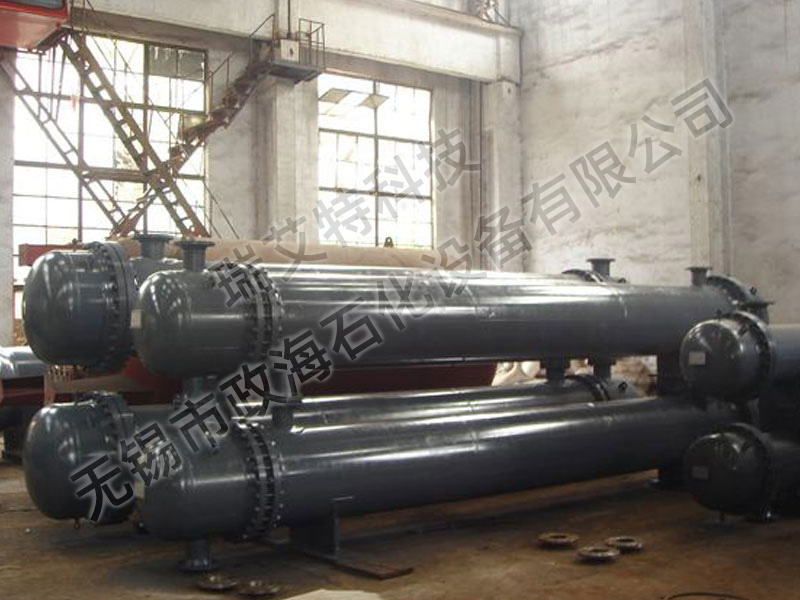Product Description
The floating head end structure of floating head heat exchanger is composed of cylinder, outer head cover side flange, floating head tube plate, hook ring, floating head cover, outer head cover, wire hole, steel ring, etc., which is characterized by: concave or ladder sealing surface is set on the inner side of outer head cover side flange, and holes are drilled and threaded or welded on the outer side close to the sealing surface, multiple screws are evenly distributed, hook ring and related parts are cancelled at the floating head, The floating head tubesheet sealing groove is the original concave groove, and a ladder groove with the center of the tubesheet as the center and the radius slightly larger than the outer diameter of the tube bundle is opened on the same end face, and the split groove of the tubesheet is only connected with the ladder groove, but not with the concave groove.
brief introduction
One end of the tube sheet at both ends of the floating head heat exchanger is not connected with the shell, which is called floating head. When the tube is heated, the tube bundle and the floating head can expand and contract freely along the axial direction, which completely eliminates the temperature difference stress.
structure
A plurality of screws are drilled and threaded or welded evenly between the concave and ladder shaped grooves. The floating head flange is double sealed with convex and ladder shaped boss. The split plate is communicated with the ladder shaped boss and is located at the same end face of the wide face flange. The convex and ladder shaped boss and split plate are respectively matched with the concave and ladder shaped groove and split groove of the floating head tube sheet, The floating head flange is assembled and welded with the non folded spherical head to form a floating head cover, and the flange screw hole is matched with the screw hole or screw of the floating head tube plate. The concave and ladder groove, split groove and gasket of the floating head tube plate are tightly pressed with bolts or nuts. If necessary, the thickness and diameter of the floating head tube plate and the inner diameter of the cylinder can be appropriately increased, At the same time, the size of relevant parts should be changed accordingly; The inner diameter of the ring is larger than the outer diameter of the floating head tube sheet. One end of the ring is provided with a flange to connect and seal with the concave or ladder sealing surface on the inner side of the flange on the outer head cover side, and the other end is provided with a flange or other structure to seal with the original concave groove of the floating head tube sheet and its gasket or outer circle.
design requirement
With the development of economy, various types of heat exchangers are developing rapidly, and new heat exchangers with new structures and materials are emerging. In order to meet the needs of development, China has established standards for some kinds of heat exchangers and formed a series of standards. Perfect heat exchanger should meet the following basic requirements in design or selection:
(1) Reasonable realization of the specified process conditions;
(2) The structure is safe and reliable;
(3) Easy to manufacture, install, operate and maintain;
(4) Economically reasonable.
Advantages and disadvantages
advantage
(1) The tube bundle can be drawn out to facilitate the cleaning of tube and shell side;
(2) The temperature difference between media is not limited;
(3) It can work under high temperature and high pressure. Generally, the temperature is less than or equal to 450 ℃ and the pressure is less than or equal to 6.4 MPa;
(4) It can be used in the situation of serious scaling;
(5) It can be used in the situation where the tube side is easy to corrode.
shortcoming
(1) Small floating head is prone to internal leakage;
(2) The consumption of metal materials is large and the cost is 20% higher;
(3) Complex structure
main features
The tubesheet at one end of the floating head heat exchanger is fixed between the shell and the tube box, and the tubesheet at the other end can move freely in the shell, which can be seen in the field. The heat expansion of the shell and the tube bundle of the heat exchanger is free, and the tube bundle can be drawn out, which is convenient for cleaning between and in the tubes. Its disadvantages are complex structure, high cost (20% higher than fixed tubesheet), leakage at floating head during operation, and difficult to check and handle. The floating head heat exchanger is suitable for the conditions of large temperature difference between shell and tube bundle or easy scaling of shell side medium.





